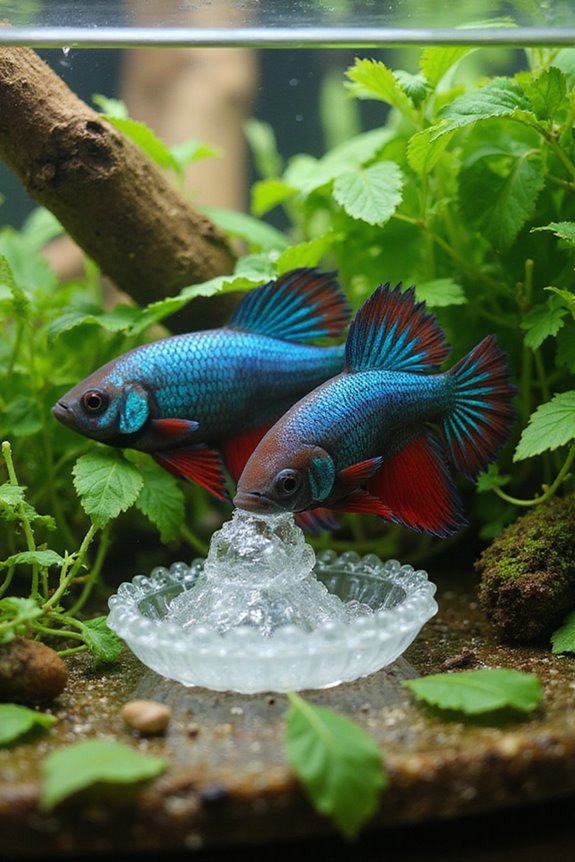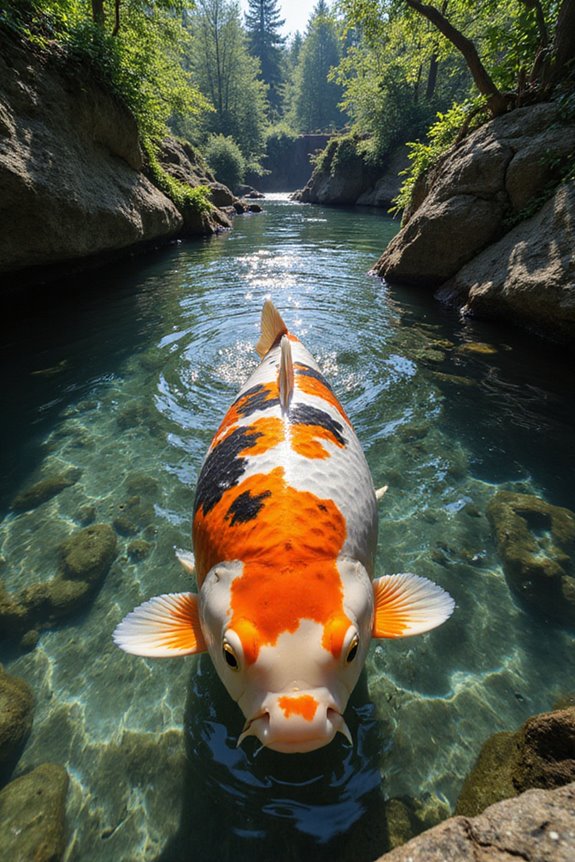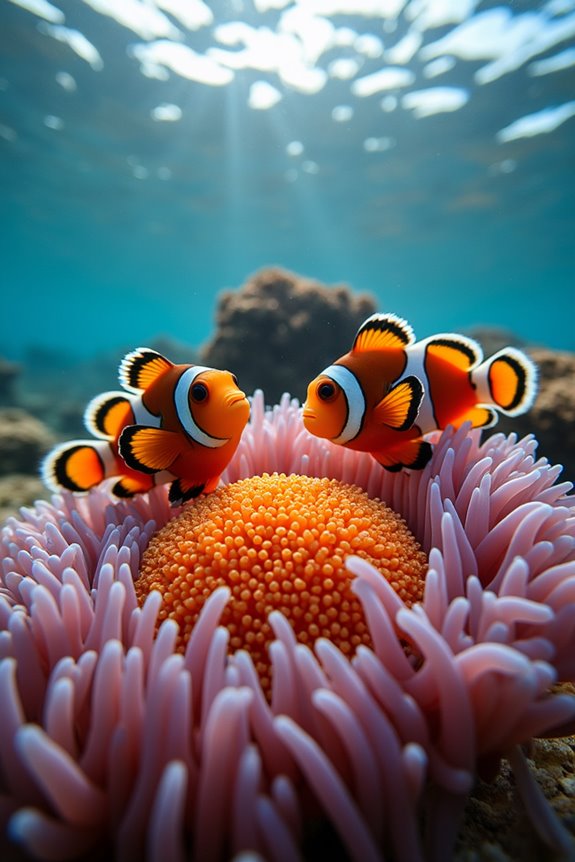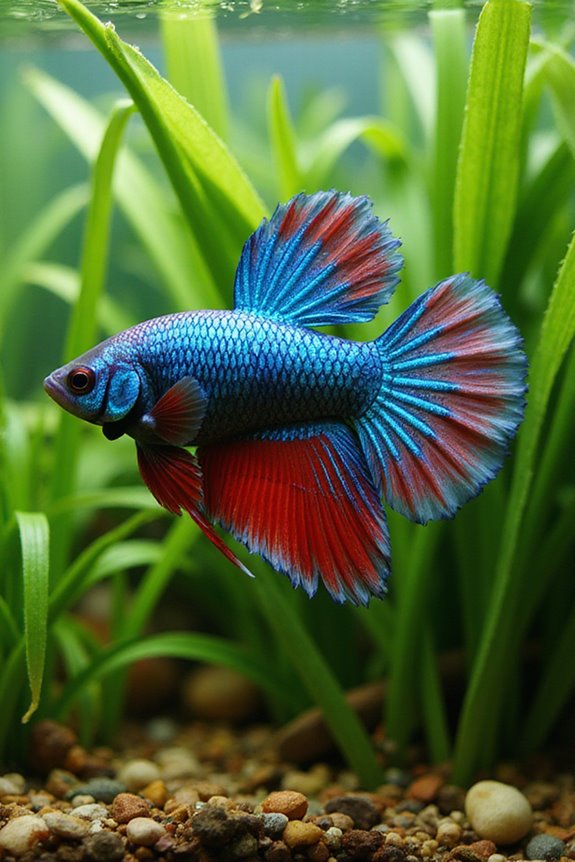To breed betta fish, set up a 10-gallon breeding tank with a heater to maintain 77-80°F and a sponge filter for gentle filtration. Choose a healthy male with vibrant colors and a slightly smaller, ripe female. Condition them with live foods for ten days. Introduce them using a tank divider, and once the male builds a bubble nest, release the female. After spawning, remove the male and guarantee ideal water quality for the hatchling’s development. More detailed steps follow.
Key Takeaways
- Set up a dedicated breeding tank with stable water conditions, including temperature and gentle filtration for optimal spawning.
- Select a healthy breeding pair, conditioning them with nutrient-rich foods for at least ten days before introduction.
- Introduce the female using a divider, observing the male’s courtship behaviors before releasing her for spawning.
- After hatching, remove the male to prevent fry predation, maintaining high water quality and providing adequate shelter.
- Keep detailed records of breeding attempts to learn from experiences and improve future breeding outcomes.
Breeding Setup and Equipment
Creating a proper breeding setup for betta fish is essential for a successful spawning experience. I recommend using a dedicated breeding tank, ideally 10 gallons, to guarantee stability and reduce stress. Maintain water parameters by keeping the temperature between 77-80°F, using an adjustable heater for temperature control. Install a sponge filter for gentle filtration and aeration methods that won’t disturb the bubble nest. Include nesting materials like Indian almond leaves, and use minimal tank decorations, such as Java moss, to provide hiding spots while enhancing humidity. Set up dimmable light conditions to simulate natural cycles, which helps during courtship. Regularly test water quality to prevent any toxic buildup and guarantee a safe environment for both breeding pairs and fry. Consider installing an automatic fish feeder with moisture-proof technology to maintain a consistent feeding schedule for the breeding pair during critical bonding periods.
Selecting and Conditioning Breeding Pair
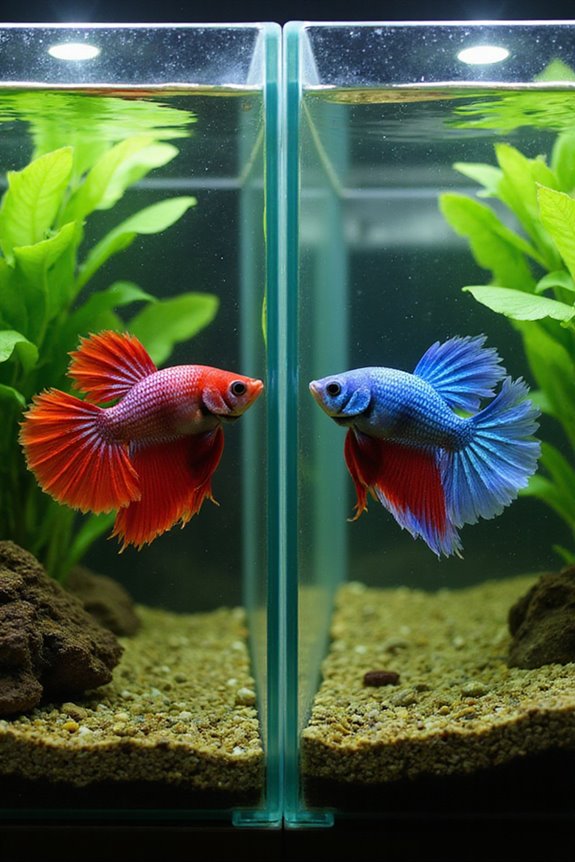
Selecting and conditioning a breeding pair of betta fish is essential for achieving a successful spawning outcome. Start with a health evaluation of both the male and female. Choose a healthy, vigorous male, preferably a Halfmoon Plakat, with vibrant coloration and good fin structure. The male should show bubble-nesting behavior, indicating readiness. For the female, select one that’s slightly smaller, in good body condition, and displaying signs of ripeness. Both fish must be free from deformities or signs of illness. During the conditioning period of at least ten days, feed them nutrient-rich live foods, maintain pristine water conditions, and observe for any compatibility issues. This preparation enhances stamina and improves the chances of successful spawning and quality fry. Similar to how proper disposal methods are crucial for biodegradable fishing lines, responsible breeding practices ensure minimal environmental impact on aquatic ecosystems.
Breeding Process and Pair Introduction
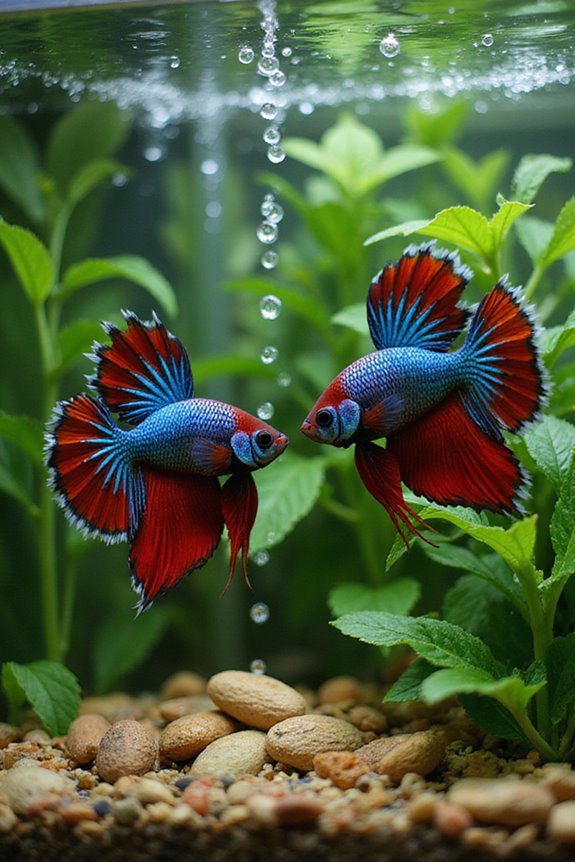
With the breeding pair selected and conditioned, it’s time to focus on the breeding process and how to properly introduce them. Set up a separate breeding tank with gentle filtration, maintaining a temperature between 75-82°F and pH from 6.5-7.0. Add plants for hiding spots and a soft substrate for the male’s bubble nest. Use a tank divider to introduce the female without direct contact initially. After about 30 minutes, observe the male’s courtship signals, like fin flaring and bubble nest building. Watch for the female’s barring, indicating her readiness. If she responds positively, gradually release her. Monitor their interactions closely, as their courtship dance can lead to successful spawning if both fish are comfortable and cooperative. Similar to how fluorocarbon fishing lines remain virtually invisible underwater, it’s essential to ensure minimal disturbance during the betta spawning process.
Egg and Fry Care
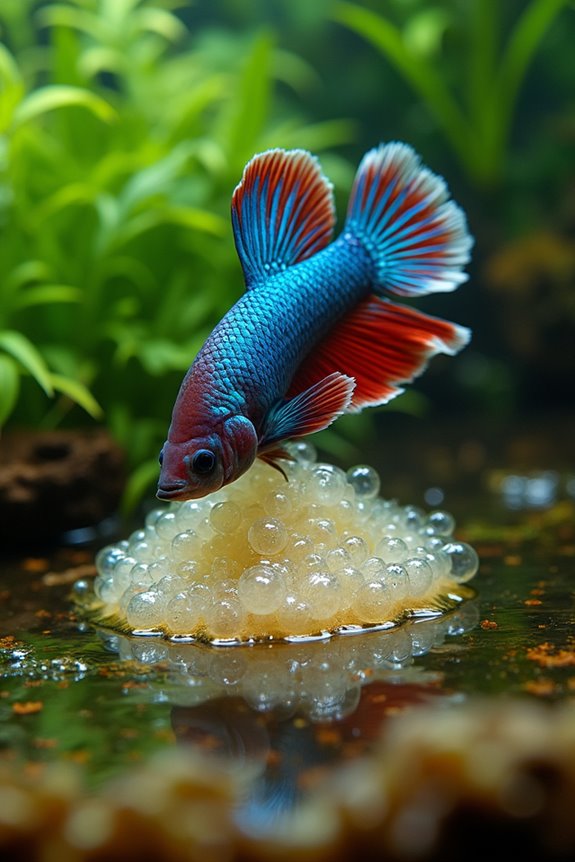
Egg and fry care is essential for the successful rearing of betta fish, as proper attention to their needs can greatly enhance their survival rates. During egg incubation, the male betta diligently protects the bubble nest, ensuring ideal conditions by maintaining a water temperature of 80-82°F (27-28°C). After 24 to 48 hours, the tiny eggs hatch, and the fry sink to the bottom for the first few days. As fry behavior changes, they become free-swimming around day three. It’s crucial to remove the male soon after, as he may eat the fry. To support their development, use a tank lid to maintain humidity and add floating plants for shelter, creating a comfortable environment that mimics their natural habitat.
Feeding the Fry
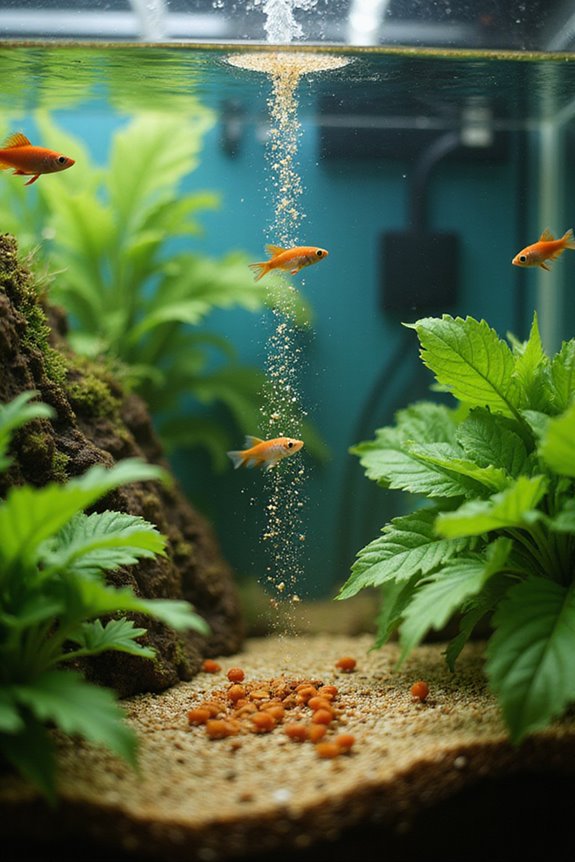
Feeding betta fry is a crucial aspect of their early development, as they require specific nutrients to thrive. I recommend starting the feeding schedule around 60 hours post-spawning. Offer multiple small feedings throughout the day, ensuring each feeding lasts about 3-5 minutes. This method encourages ideal growth and prevents overfeeding.
Baby brine shrimp is a preferred food type due to its high fat content. For variety, you can use powdered fry foods, but betta fry often ignore them. Be cautious with liquid fry foods, as overfeeding can lead to mortality. I also suggest Repashy gel foods, allowing fry to graze continuously. Remember to remove any uneaten food promptly to maintain water quality.
Water Quality and Maintenance
Maintaining ideal water quality is vital for the health and growth of betta fry, especially after they’ve been fed. I recommend keeping the water temperature between 76°F and 82°F using a reliable aquarium heater. This temperature range supports their immune health. Guarantee pH stability between 6.5 and 7.5, testing regularly with a quality pH kit. For water hardness, maintain a general hardness of 4–15°N and a carbonate hardness of 5–6 to buffer pH. Effective filtration systems are essential for removing toxins like ammonia and nitrates, so choose a good filter and avoid over-cleaning the media. Regular water changes of 25-30% weekly, along with substrate maintenance, will help maintain favorable conditions for your bettas.
Common Challenges and Solutions
When breeding betta fish, addressing common challenges can greatly enhance your success rate. First, focus on aggression management. I recommend using a divided breeding tank or an acclimation cage to minimize direct aggression until they show spawning behavior. Next, guarantee environmental stability. Keep the spawning tank shallow, around 10-15 cm, and maintain a stable temperature of 27-28°C. Use floating plants or artificial covers for nest building and hiding. Clean the tank regularly to avoid ammonia buildup, which is harmful to fry. Finally, monitor the male post-spawning; if he becomes overly aggressive, remove the female to protect her and the eggs. By tackling these issues proactively, you can create a conducive environment for successful breeding.
Growth and Development of Fry
Understanding the growth and development of betta fry is essential for ensuring their healthy change from hatchlings to juvenile fish. Initially, fry rely on the yolk sac for sustenance, which is absorbed within the first two to three days. Once they shift to free-swimming, their swim bladder begins to develop, allowing for better mobility. During the first month, fry typically grow at a rate of about 1 mm per day. By three weeks, fin development starts, indicating future shape and potential coloration. As they reach eight weeks, fry begin exhibiting aggressive behavior and sexual maturity, making it vital to separate males to prevent fighting. Proper feeding practices, including small live foods, enhance their growth and support the development of their labyrinth organ.
Final Thoughts on Breeding Bettas
Breeding bettas successfully requires careful attention to multiple factors, from the health of the parent fish to the conditions in which they spawn. I’ve learned that ethical considerations play a significant role in breeding techniques. Always prioritize the well-being of your bettas. Make certain they’re of ideal size, at least 4 cm for males and 4.5 cm for females, to enhance mating success. Provide a clean, stable environment with proper water temperature and quality. Utilize live or frozen foods to stimulate energy and encourage bubble nest building. Monitor your bettas closely for any signs of stress or aggression, and separate them if necessary. Maintain detailed records of your breeding pairs to learn from past experiences, guaranteeing future successes.
Frequently Asked Questions
Can Bettas Breed in Community Tanks With Other Fish?
I wouldn’t recommend breeding bettas in community tanks. The tank environment can stress them and other fish, compromising breeding compatibility. It’s best to use isolated setups to guarantee a successful breeding process without interference.
How Long Does It Take for Betta Eggs to Hatch?
Betta eggs typically hatch within 24 to 72 hours, depending on hatching conditions. I’ve noticed that ideal temperatures greatly speed up egg development, sometimes leading to hatching around 36 to 48 hours. It’s fascinating!
What Signs Indicate That a Female Betta Is Ready to Breed?
Isn’t it fascinating how a female betta’s breeding behavior reveals her readiness? I’ve noticed signs like a plump belly, darkened colors, and that white dot—each one signals she’s ready to spawn and mate!
Can I Breed Bettas Without a Bubble Nest?
I’ve found that breeding bettas without a bubble nest is possible through alternative methods, but it requires ideal breeding conditions. You’ll need to carefully manage eggs and fry to guarantee their survival without the father’s protection.
What Should I Do if the Male Betta Refuses to Care for Fry?
If my male betta refuses fry care, I’d make certain he’s well-fed and the tank’s calm. I’d monitor his behavior closely; stress and poor conditions can lead to neglect, so keeping him comfortable is essential.

